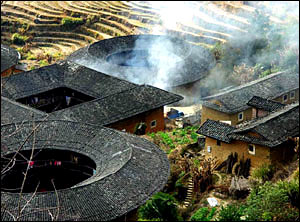
The Hakkas, usually mistakenly regarded as a minority race in China, are actually a unique ethnic sub-group of the majority Han nationality. Their ancestors lived around the Yellow River area and are thought to be one of the earliest Han settlers in China.
They began to migrate to South China to avoid the wars and conflicts of the late Western Jin Dynasty (AD 265-316).
The early Hakkas were thought to have "royal blood" and while maintaining their Han culture, Hakka people married into other ethnic groups and adopted something of other cultures during their long history of migration.
Moving from China's northwest, north and northeast, the original settlers gradually migrated south and settled in Jiangxi, Fujian, and Guangdong provinces in eastern and southern China.
They were called Hakka by the locals when they first arrived in the south and the term is derived from the pronunciation of their name in Hakka dialect ("haagga", or "kejia" in Mandarin). "Ke" means "guest" and "jia" means "family" or race, so the original meaning of "hakka" was "guests" in their new settlement areas.
Many Hakka people migrated further -- to South East Asia, East Africa, Europe, South America, Canada and the US in the past 100 years or so.
Hakka people are well-known for their preservation of certain cultural characteristics that can be traced back to the pre-Qin Dynasty period (more than 2,200 years ago) as evidenced by their customs, cuisine and dialect.
As latecomers, Hakkas usually had to struggle to survive on less desirable land. They inhabited the mountainous regions in Fujian and Guangdong provinces, striving for a better life while preserving their own culture.
Earth house
The round "Earth Houses", the homes of the Hakkas, were built with the initial aim of keeping the people together and fending off attacks from the other ethnic groups among whom they had settled.
The diameter of a small "Earth House" was about 50m and could accommodate 30-40 families. Bigger "houses" had diameters up to 80m which could hold a "village" of some 700 to 800 people.
"Earth Houses" were also built in square and "Five-Phoenix" shapes. A "Five-Phoenix" building, also known as a "Curling Dragon House", was an older type of earth structure, popular in the early Hakka migratory period and could be found in southern Jiangxi and eastern Guangdong.
The "Curling Dragon" buildings were the most representative of Hakka traditional zhongyuan (Central China) culture as they were built according to the imperial court pattern.
When the first Hakkas came to Fujian and Guangdong provinces, they could afford the luxurious "Five-Phoenix" houses, modelled on the style of housing in the imperial court. The houses were built on the same axis and comprised two or three buildings and a gate.
The Hakkas gradually lost their connection and relationship with the imperial court and had to compete with the local people on equal terms. They no longer had the support of the imperial court because it was hard for the imperial power to reach the remote areas where they lived.
Without imperial protection the Hakkas came under attack from the local population. This led to the construction of the defensive round houses, which evolved from the square buildings and the "Five-Phoenix" structures.
The smaller round houses had two or three storeys built in a single ring. The medium-sized dwellings had three or four storeys with a larger inner space and double rings. The larger ones were built in three concentric rings.
The rings of round houses, built around the same central point, spread like ripples through the green mountain regions of East and South China. An ancestral hall was located in the centre of a round house and was regarded as a holy place in the building.
The wall of a round house was usually 1 metre thick at the base, thinning towards the roof.
"The design of the walls saved on the materials and ensured that the buildings could survive storms and earthquakes," said Zhong Fulan, a professor at East China Normal University.
Tight community
A typical room was about 10 to 13 square metres and each family had three rooms. The families in the round houses often had the same blood relationship. As there was only one main stairway in each building and the rooms were connected, privacy was hard to maintain.
Another expert on earth buildings, Sun Xiaoning, said that the round houses were easy to defend, saved space and the round design ensured enough light.
Professor Zhong said: "It also has other meanings. The circle symbolizes gathering together and unity in China."
The buildings showed that the Hakka people liked to live together in tight communities. As a minority group among the local population, it was necessary for them to co-operate with one another to survive attacks both militarily and cultural from the local people.
Each Earth Building had only one entrance and became a strong castle once the gate was shut and guarded by a few people.
The Hakkas stored their food and raised pigs and chickens in the buildings. They dug wells and built complicated drainage systems in their buildings and could survive for long periods when cut off from the world outside.
Each building, in fact, was like a well-run village in which the Han culture was preserved and passed on.
(Shanghai Star May 27, 2004)
|

